This guide will introduce you to some of the most notable evergreen plants that prefer wet soil, showcasing their unique characteristics, habitat preferences, and cultivation tips. From majestic trees to resilient shrubs, here’s a guide to evergreens that enjoy the embrace of wet soil.
Bald Cypress (Taxodium distichum)

The Bald Cypress is a magnificent tree native to the southeastern United States, commonly found in swampy areas and along riverbanks. This tree can grow up to 100 feet tall and is renowned for its distinctive, conical shape. What sets the Bald Cypress apart from many other trees is its ability to thrive in very wet soil conditions. It can even grow partially submerged in water, making it an excellent choice for flood-prone areas.
The tree’s feathery, needle-like leaves turn a beautiful copper-brown in the fall before dropping for the winter months—a rare trait among evergreens. Bald Cypress also provides essential habitat for wildlife, including birds and insects. Its unique root structures, known as “knees,” protrude from the ground near the water to help with stability and gas exchange. Planting a Bald Cypress in the right environment can lead to a stunning focal point in any landscape while also contributing to local biodiversity.
Arborvitae (Thuja occidentalis)
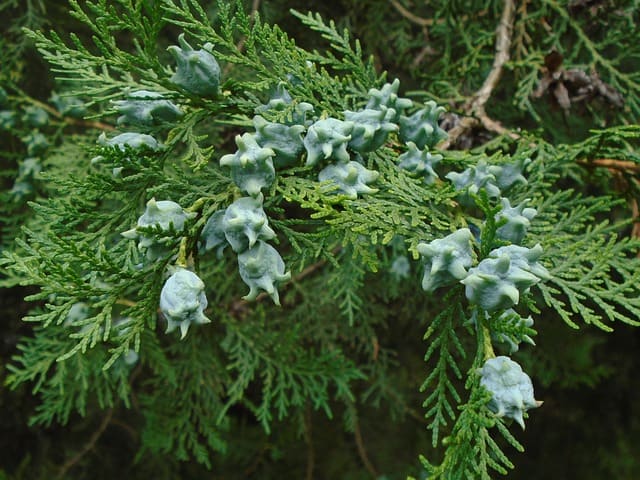
Arborvitae is a versatile evergreen known for its dense, pyramidal shape and rich green color. Commonly used as a hedge or privacy screen, this resilient plant can tolerate various soil conditions, including wet environments. They thrive in USDA hardiness zones 2 through 7, making them suitable for many areas across North America.
These evergreens feature soft, scale-like leaves that provide excellent coverage, making them popular among gardeners looking to create lush backdrops or windbreaks. Arborvitaes are also incredibly low-maintenance. With a little care, they can flourish in wet, poorly drained soils, adding structure and beauty to any landscape.
American Cranberry (Vaccinium macrocarpon)

While not a traditional evergreen tree, the American Cranberry is an intriguing plant that loves wet soil and offers a unique combination of ornamental and practical use. Known for its glossy green foliage and stunning red berries, this low-growing shrub is often found in bogs and wetlands. The berries produced by this plant are not only visually appealing but are also packed with antioxidants and can be harvested for jams and jellies.
American Cranberry excels in moist to wet soils and can even thrive in acidic conditions. Beyond its utility, its beautiful leaves turn a striking reddish tint in the fall, making it a favorite among homeowners looking for seasonal interest. This resilient plant can flourish near ponds or in border areas, providing a habitat for local wildlife and attracting birds eager to feast on its nutritious berries.
Inkberry (Ilex glabra)
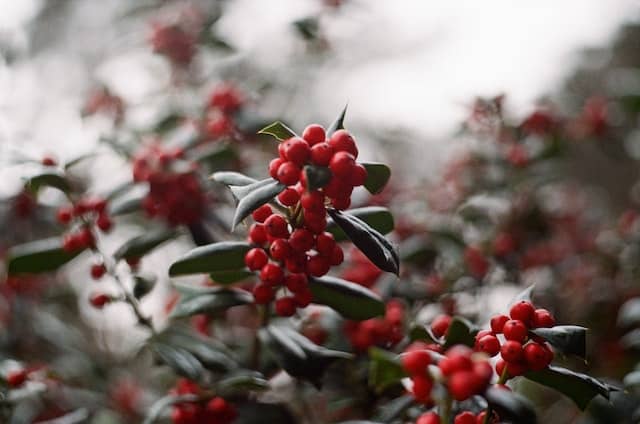
Inkberry is an evergreen shrub that thrives in wet soils and is native to the Eastern United States. Traditionally found in low-lying areas like wetlands, it is an excellent choice for gardeners dealing with problematic drainage. This plant has glossy, dark green leaves and produces small black berries that birds love, enhancing the landscape’s wildlife value.
Inkberry is adaptable and provides excellent ground cover. It typically grows between 3 to 5 feet tall, making it ideal for filling in gaps in garden beds or as a foundation plant. Besides its attractive foliage, Inkberry’s tolerance for wet soil makes it a fantastic option for rain gardens or near water features, ensuring that your landscape remains vibrant and lively even in challenging conditions.
Hardy Anise (Illicium parviflorum)
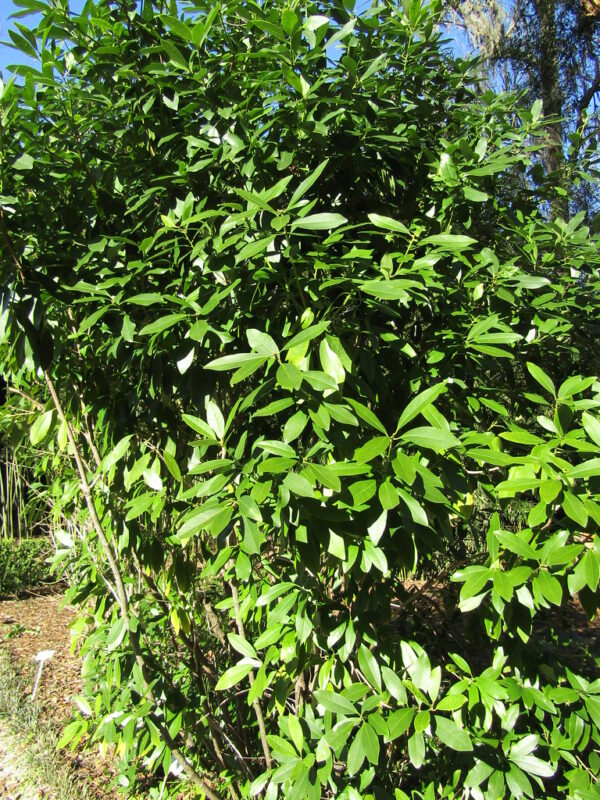
Hardy Anise is a compact evergreen shrub native to the southeastern United States that thrives in moist, acidic soils. Known for its aromatic leaves that emit a sweet licorice scent when crushed, this plant adds both scent and beauty to any garden. Hardy Anise grows to about 3 to 6 feet in height and is perfect as a low hedge or accent plant.
In addition to its appealing fragrance, it features glossy green foliage that remains vibrant year-round. Hardy Anise flourishes in shade to partial sun, making it a perfect choice for woodland gardens or areas with filtered light. Its ability to tolerate wet soil makes it especially desirable for transitioning areas between dry and damp areas, helping to manage moisture levels gracefully while adding a unique sensory element to the landscape.
Chinese Swamp Cypress (Glyptostrobus pensilis)

The Chinese Swamp Cypress is a deciduous conifer that is often mistaken for an evergreen due to its bushy appearance and soft green needles. Rare and less common than its American counterpart, this unique tree flourishes in wetland habitats, often found along riverbanks and in flood-prone areas. Though it boasts a similar growing habit to the Bald Cypress, it showcases qualities that make it stand out.
Reaching heights of around 50 to 70 feet, the Chinese Swamp Cypress provides stunning vertical accentuation in landscapes. This tree’s unique, peeler-like bark offers significant visual interest throughout the seasons. Its unique adaptations for very wet conditions make it an exceptional choice for lakeside plantings, offering home gardeners a resilient and visually striking option for wet soils.
Wax Myrtle (Morella cerifera)

Wax Myrtle is a fantastic evergreen shrub or small tree native to the Southeastern United States, possessing a fragrant aroma that adds sensory appeal to gardens. Thriving in a range of soils, including wet or poorly drained areas, Wax Myrtle grows well in USDA hardiness zones 7 through 10. It also acts as a natural screen or windbreak due to its dense foliage.
The small, aromatic leaves of Wax Myrtle are popular among wildlife, attracting various birds and insects. Its berries can also be eaten by many bird species, contributing to ecosystem diversity. This adaptable plant can be left unpruned for a more natural look or trimmed into a more formal hedge, making it a versatile choice for diverse landscaping needs.
Southern Magnolia (Magnolia grandiflora)

The Southern Magnolia is a majestic evergreen tree that thrives in the moist, acidic soils of the southeastern United States. Known for its impressive size (often reaching 60-80 feet), iconic large white flowers, and glossy leaves, this stunning tree is an impressive addition to any landscape. Southern Magnolias are often seen adorning southern estates and gardens due to their striking appearance.
In wet conditions, Southern Magnolias can truly excel, offering a habitat for wildlife and providing an impressive visual focal point. Its dark green leaves provide year-round interest, while the fragrant, large white flowers bloom in the spring and summer, attracting numerous pollinators. This tree is a beloved staple of southern gardens and is quite adaptable, proving its resilience in various soil types.
American Holly (Ilex opaca)
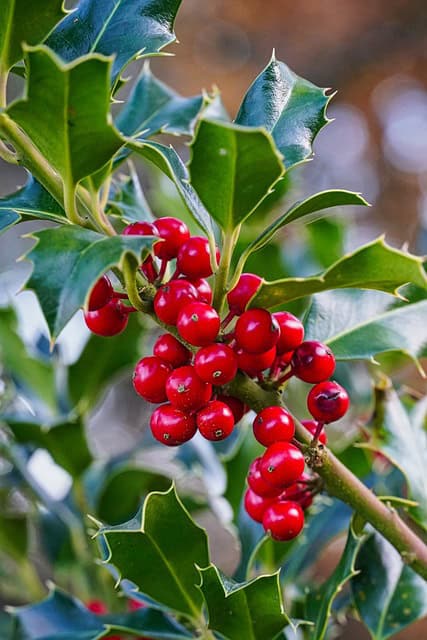
American Holly is an evergreen shrub or small tree characterized by its glossy, spiky leaves and bright red berries. Thriving in a variety of moisture levels, it is highly adaptable to wet soils, making it a popular choice for landscaping throughout the eastern United States. Growing to approximately 15 to 30 feet tall, the American Holly offers striking visual appeal when adorned with berries in late autumn and winter.
This plant’s dense foliage provides excellent privacy and sound barriers, with the added benefit of attracting birds eager to feast on its berries. Care must be taken in selecting both male and female specimens for optimal berry production. The American Holly is a classic choice for festive decorations, especially during the holiday season, making it a true multitasker in any landscape design.
Princess Flower (Tibouchina urvilleana)

The Princess Flower, hailing from Brazil, is a striking evergreen shrub known for its vibrant purple flowers and plush green foliage. While it thrives best in well-draining soils, it can adapt to moist conditions as well, making it a worthy plant for gardens that experience occasional wetness. The Princess Flower can reach up to 10 feet tall, creating a dramatic presence in any garden layout.
This showy plant produces large, stunning blooms from summer to fall, adding a colourful pop to landscapes. It’s attractive to both pollinators and gardeners, creating an inviting atmosphere for nature lovers. The blooms are not just visually striking; they also emit a mild fragrance, enhancing the overall sensory experience of the garden. With its ability to thrive in wet conditions, the Princess Flower creates an exciting focal point amidst more common garden plants.
Florida Anise (Illicium floridanum)
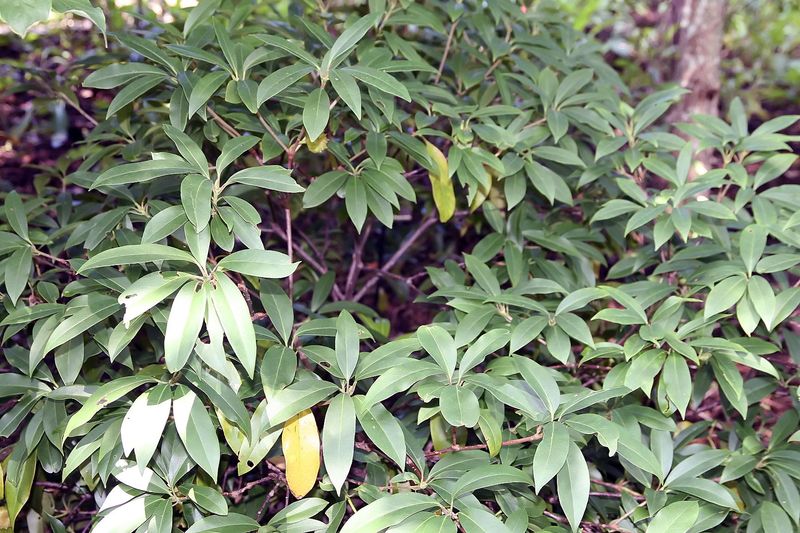
The Florida Anise is a clustering evergreen shrub that flourishes in the damp, rich soils of the southeastern United States. A close relative to the Hardy Anise, this shrub typically grows around 3 to 5 feet tall and is prized for its aromatic leaves and vibrant dark green foliage. Ideal for wildlife gardens, Florida Anise attracts birds and butterflies, adding life and excitement to any outdoor space.
This shrub does particularly well in shady conditions and can tolerate wet soils, making it a great choice for those more challenging areas of a garden. Its unique star-shaped flowers bloom in spring, enhancing the garden’s aesthetic appeal. As an evergreen, Florida Anise maintains its vibrant foliage even in winter, ensuring year-round greenery and charm.
Shining Fetterbush (Lyonia lucida)
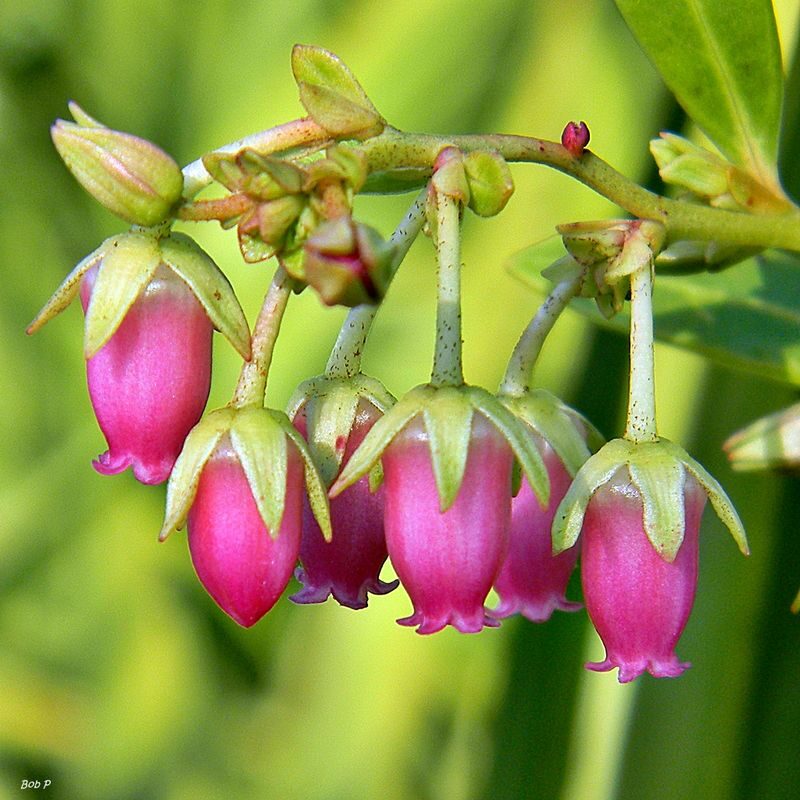
Shining Fetterbush is an evergreen shrub that thrives in the wetlands of the southeastern United States. This plant features leathery, glossy leaves, which create a striking contrast against its clusters of delicate bell-shaped white or pink flowers that bloom in late spring. The Shining Fetterbush is well-adapted to wet soils, making it a valuable addition to rain gardens or naturalized areas.
This shrub typically grows to heights of 3-6 feet and is particularly beneficial in restoring habitats and attracting pollinators. Its compact form and lush foliage provide year-round visual interest, while the spring blooms offer an enticing hint of color. As a relatively low-maintenance plant, Shining Fetterbush is an excellent choice for gardeners seeking both beauty and resilience in their wet landscapes.
Florida Leucothoe (Agarista populifolia)
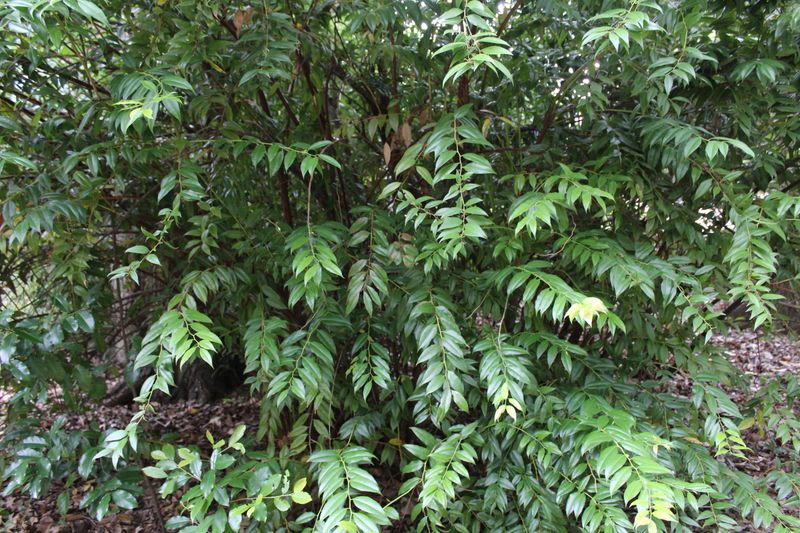
Florida Leucothoe, also known as Dog Hobble, is a lovely evergreen shrub native to the southeastern United States. Thriving in acidic, moist environments, this plant grows between 3 to 5 feet tall and is known for its cascading habit. The plant produces delicate clusters of white urn-shaped flowers in spring, attracting an array of pollinators.
Not only does Florida Leucothoe tolerate wet conditions beautifully, but its evergreen, glossy leaves also provide year-round interest. This shrub is perfect for naturalizing in woodland gardens or for use as a ground cover. Its graceful form and appealing flowers make it a charming choice for enhancing garden aesthetics while providing crucial habitat for wildlife.
Leatherwood (Cyrilla racemiflora)
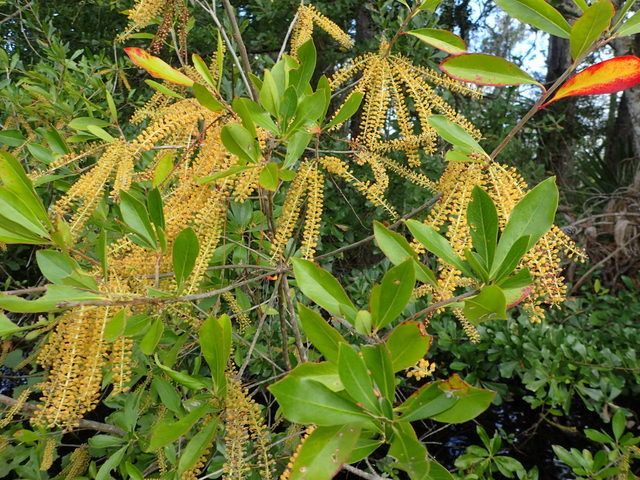
Leatherwood is a rare evergreen shrub or small tree found predominantly in the southeastern United States. Thriving in wet and high-humidity environments, this unique plant can adapt to various soil types, including poorly drained ones. Leatherwood is easily recognizable by its oval, leathery leaves and rather striking white, fluffy flower clusters that bloom in the summer.
This plant can grow up to 20 feet tall, offering vertical interest with minimal maintenance. Leatherwood’s beauty lies in its adaptability to harsh environments, providing an attractive option for wetland gardens. Beyond aesthetics, it also plays an essential role in local ecosystems, making it a vital addition to any garden design that aims to support biodiversity.
Japanese Fatsia (Fatsia japonica)

The Japanese Fatsia is a tropical evergreen shrub that thrives in rich, moist soils and can tolerate wet conditions. This visually striking plant is known for its large, palmate leaves and can reach heights of 6 to 10 feet, making it an excellent choice for creating a dramatic backdrop in the garden.
Ideal for shaded areas, especially those with consistently moist soil, the Japanese Fatsia offers lush greens throughout the growing season, along with clusters of small, white flowers that bloom in autumn. Its unique foliage makes for an attractive feature that contrasts beautifully with other plants in the space. This versatile evergreen not only enhances the aesthetics of shaded, wet areas but also provides an inviting sanctuary for wildlife.
Winterberry (Ilex verticillata)

Winterberry is a deciduous holly that thrives in wet soils, often found in swamps and lowland areas throughout the eastern United States. What makes Winterberry unique is its ability to provide visual appeal even in winter, thanks to its bright red berries that remain on the branches after the leaves have fallen.
This shrub typically grows 3 to 12 feet tall and serves as a crucial food source for birds during the cold months. Winterberry’s berries are also a common choice for seasonal decorations and arrangements. Planting male and female specimens close together is essential for berry production, turning your landscape into a lively display of contrasting colors. With its adaptability to wet conditions, Winterberry not only enriches gardens with seasonal beauty but also supports local wildlife.
Coastal Leucothoe (Leucothoe axillari)
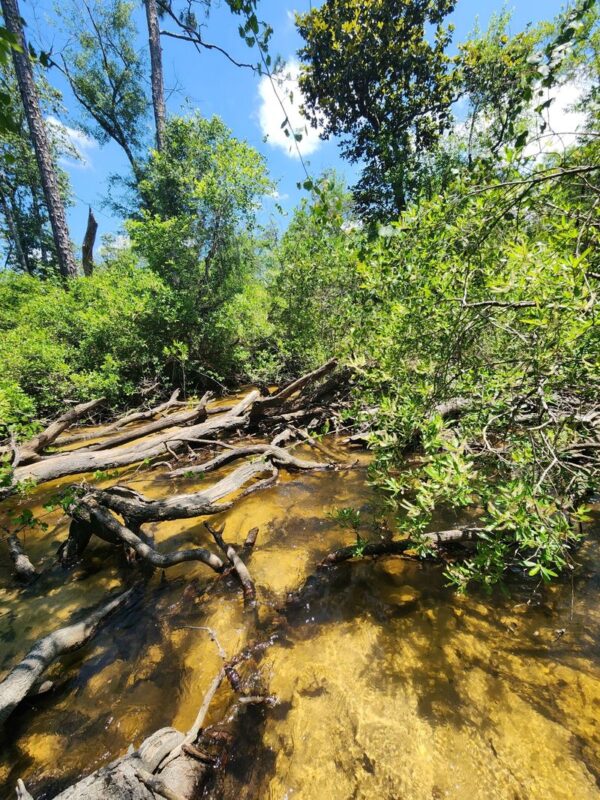
Coastal Leucothoe is a charming evergreen shrub that thrives in moist, acidic soils, often found in coastal areas of the southeastern United States. This shrub is known for its arching branches and leathery leaves, creating an appealing cascading effect in landscape designs. Growing to around 3-4 feet tall, Coastal Leucothoe produces pendulous clusters of small white bell-shaped flowers in spring, enhancing gardens with a touch of elegance.
Perfect for shaded spots and areas with high moisture, this plant is excellent for naturalizing and creates a soft, flowing look in garden beds. Coastal Leucothoe’s adaptability makes it a great choice for rain gardens or areas in need of formal plantings. Its beautiful leaves and delicate blooms provide year-round interest, while its tolerance for wet soil ensures it thrives even in challenging conditions.
Devilwood (Osmanthus americanus)
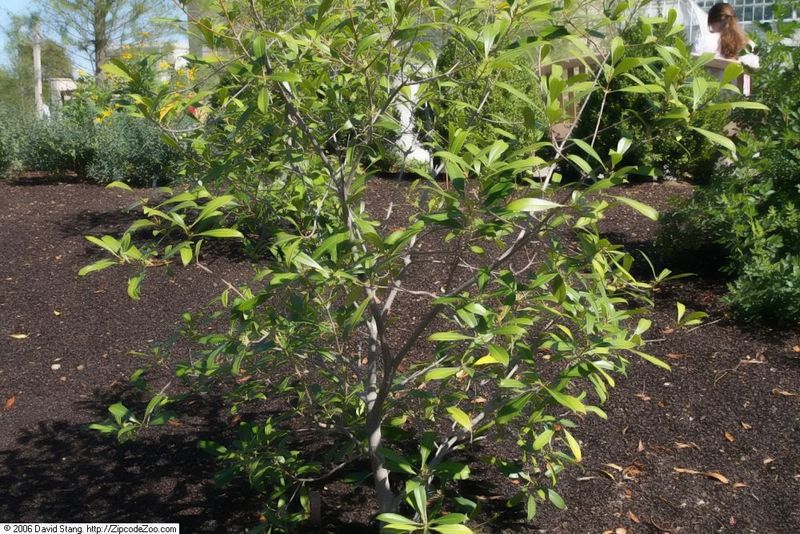
Devilwood, also known as Wild Olive, is an evergreen tree or shrub native to the southeastern United States, particularly thriving in lowland, wet areas. This adaptable plant can grow up to 30 feet tall, exhibiting a broad, irregular shape. Its dense foliage consists of dark green leaves that serve as an essential habitat for birds and insects.
In late summer to early fall, Devilwood produces small white flowers that emit a delightful fragrance, attracting pollinators into the garden. This fragrant element adds another dimension to its allure, making it an excellent choice for scentscape gardens. Devilwood is remarkably resilient and can tolerate wet to moderately dry conditions, providing a versatile option for difficult landscapes.
Dwarf Palmetto (Sabal minor)
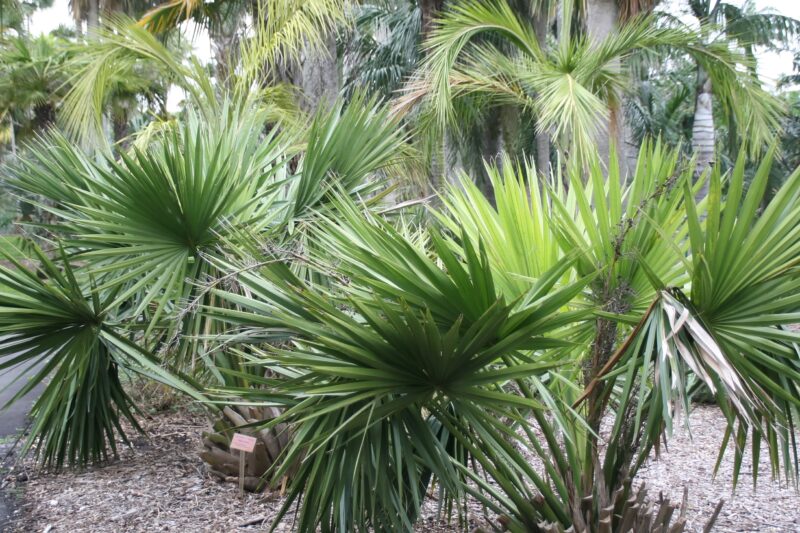
Dwarf Palmetto is a small, clumping palm native to the southeastern United States, particularly suited for wet and swampy areas. This hardy palm typically grows 3 to 7 feet tall, making it the perfect accent plant for small gardens or natural areas along the water. The fan-like leaves create a lovely tropical look, contributing texture to the landscape.
This palm is exceptionally tolerant of wet soils and can thrive in partially submerged conditions, making it a unique choice for water gardens. Dwarf Palmetto not only adds visual interest but also supports local wildlife, providing shelter and food. Its incredible adaptability, coupled with its evergreen nature, ensures that it thrives in challenging locations while enhancing any landscape with its lush greenery.





